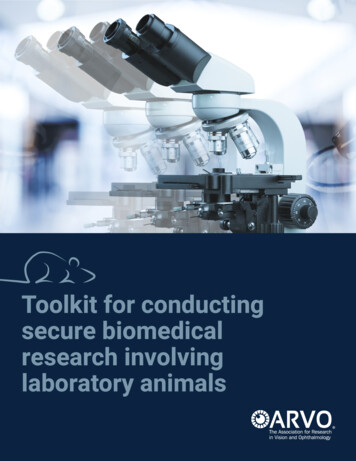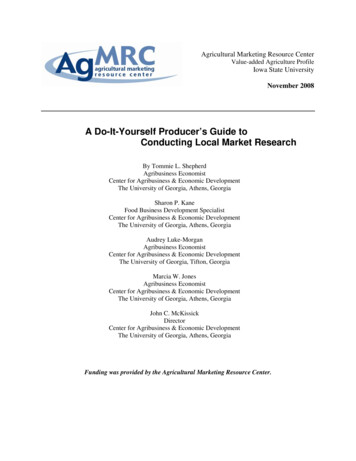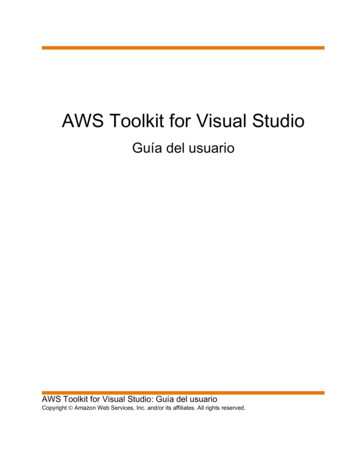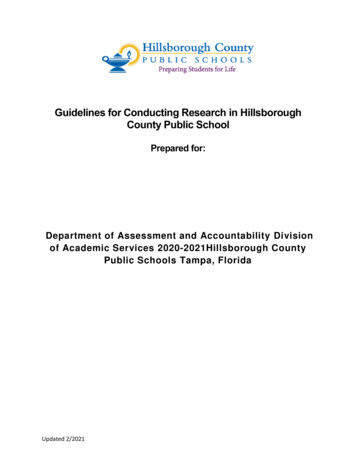
Transcription
Toolkit for conductingsecure biomedicalresearch involvinglaboratory animals
ARVO Toolkit for Conducting Secure BiomedicalResearch Involving Laboratory AnimalsContentsIntroduction: Conducting animal researchin an age of animal rights -------------------------- 1Resources to help limit the impact of threats and attacks-------------------------------------- 1Coordinate with your institution ------------------- 5Establish security ---------------------------------- 6Responding to public scrutiny and requests for informationabout the use of animals in your ---------------10What to do if confronted or targetedby animal-rights -------------------------------------11Know and understand the -------------------------13What ARVO can do for -----------------------------14Educational ------------------------------------------15Other groups providing information,resources and assistance ----------------------------15Sample research project -------------------------17Revised: 12/2021
ARVO Toolkit for Conducting Secure Biomedical ResearchInvolving Laboratory AnimalsIntroduction: Conducting animal research in an age of animal rightsactivismThe Association for Research in Vision and Ophthalmology (ARVO) leadership considers the use ofanimals in research as one of the most important and critical issues facing vision scientists today. Theuse of animals in properly designed vision research experiments is both ethical and necessary for thegeneration of the new knowledge needed to develop new treatments to protect people and animals fromvisual diseases and defects.Investigators who use animals must assume responsibility for the proper scientific and ethical design ofexperiments, as outlined in the ARVO Statement for the Use of Animals in Ophthalmic and VisionResearch.This toolkit has been prepared and updated by the ARVO Animals in Research Committee to suggestboth proactive and reactive strategies for ARVO members who use animals in their research. Use thelinks in the Table of Contents to jump to areas of immediate interest. The Animals in ResearchCommittee also urges ARVO members to read this Toolkit and offer suggestions or additions for the nextversion. If you are targeted by an animal‐rights activist organization, please contact ARVO staff viaarvo@arvo.org.Extreme acts from animal‐rights activists have escalated to include personal attacks on researchers’homes, property and, in some cases, family members. The activities range from online harassment,picketing and harassment of investigators at their workplace or home, to vandalism and even attemptedhomicide. The frequency and severity of the acts of terror against scientists has led to manyinvestigators “going underground” and disengaging from public discourse on animal research. However,in the absence of advocacy and education, the resulting information void has been filled by a campaignof disinformation and misinformation by activist organizations. This underscores the importance ofeducating the public on the necessity of animal research, as well as educating scientists on strategies toprepare for and cope with pressure from an animal‐rights group.Resources to help limit the impact of threats and attacksProtecting your lab personnel and research against an attackIf your research requires the use of animals, you should follow several steps, regardless of whether youthink your work may be targeted. These are proactive measures that will give you initial security andsave you stress if you are attacked. This section presents an overview of what you need to do to protectyourself. The National Association for Biomedical Research (NABR) has prepared an Animal ResearchCrisis Management Guide that contains detailed information.Make sure your research complies with applicable national and local regulationsEvery ARVO researcher using animals must be familiar and comply with all applicable policies,regulations and/or requirements of governing institutional and national organizations and must followRevised 12/2021 1
the ARVO Statement for the Use of Animals in Ophthalmic and Vision Research. In the event that youare targeted by activists, ARVO will vigorously defend and support you after reviewing your research toensure its compliance with this ARVO statement.Develop and maintain an animal use research project fileIn addition to the files normally maintained for your research project, you should start and regularlyupdate a file that contains background material that is useful in case there is an inquiry about the useand care of animals in your research. This will ensure a prompt and measured response. Forinvestigators conducting multiple projects, it is recommended that each project has a separate file orsub-file, making it easier to respond to specific requests without the release of unnecessary information.Establish security proceduresAt a minimum, every researcher should have a personal and professional security plan and coordinate itwith institutional security representatives and local police. Animal rights activists tend to wax and wanein their attentions and attacks, so researchers must always be prepared.Coordinate with your institutionYour institution is responsible for being prepared to defend itself – and you – against allegations ofanimal abuse made by animal‐rights activists. Your institution should have an administrative plan ofaction for responding to such an incident. You should meet with the person responsible for activatingthe plan and review the procedures.Preemptive security measuresARVO is not able to provide information to members covering institution‐specific policies forbackground checks and security clearances when hiring employees who access animal research facilities.Members should work with their institutions to ensure adequate safety of personnel, research animalsand security of study data, and should prepare an action plan for responding to adverse incidents.Use care in wording your research documentsRemember that non‐scientists and others may read your publications and grant documents. This appliesespecially to federal grant applications, institutional documents and manuscripts describingexperimental procedures involving animals.Become an advocate for animal researchIt is important to apprise members of the public and your local and national legislators about theimportance of using animals in research, and the improvements in human and animal health that havearisen as a result of studies using animals. Written statements focusing on the scientificbenefits/advances of your research efforts are particularly useful. Get involved in organizations whichsupport science and the benefits of animal research to society.Make sure your research complies with applicable national and local regulationsUnited States US Animal Welfare Act and Regulations: A document with regulations to improve animal careand use in research, testing, teaching and exhibition.Office of Lab Animal Welfare Public Health Service Policy on Humane Care and Use ofRevised 12/2021 2
Laboratory Animals: A tutorial for new animal care and use committee members, institutionaladministrators, investigators, animal care personnel and veterinarians.ILAR Guide for the Care and Use of Laboratory Animals: Primary reference on animal care anduse (required if research is conducted with Public Health Service funds).NIH 2008 Guidance for Researchers & Institutions: Good animal care and good science go hand‐in‐hand: A list of resources for research that involves NIH grants.Institutional Animal Care and Use Committee (IACUC) within your institution.Other local or state regulations that may be in effect where your research is conducted.Canada Guide to the Care and Use of Experimental Animals by the Canadian Council of Animal Care: Forresearch conducted in Canada.United Kingdom and African continent Responsibility in the use of animals in bioscience research: Expectations of the major researchcouncil and charitable funding bodies: Medical Research Council (MRC) guide for the use ofanimals for MRC funded researchers in UK and Africa.European Union EU legislation on the protection of animals used for experimental and other scientific purposes:Legislation passed by the European Commission that governs the use of laboratory animals.Germany The German Animal Protection Act. Tierchutzgesetz (TschG), in German.Israel The Israeli Animal Protection Act, in HebrewDevelop and maintain an Animal Use Research Project FileSome universities will have well-developed online, secure depositories for maintaining the documentsrequired for meeting legal regulations surrounding the use of animals for scientific purposes in theircountries. Other universities may have less well-developed systems and thus place more responsibilityon individual researchers to keep all the necessary documents. Described here is a list of somedocuments you will need (if in the USA) or, if you are located in another country, might like to considerdeveloping. Storing these in a well-organized, secure electronic depository with separate folders foreach project is helpful. Keep in mind approval expiry dates and approved animal use numbers, as thesedocuments should be the most current versions.At the forefront of all animal research are the 3R principles (replacement, reduction, refinement). Allresearchers should be able to clearly explain how they have approached the 3R process in the design oftheir research methodologies, and should adhere to best practice principles. Animal health and wellbeing should be at the center of all research, including environmental enrichment and minimization ofpain and suffering. Showing sincere care and concern for animals is important and this needs to bereflected in the documents (even if they are only intended to be viewed at the university level). Thesedocuments should clearly show that researchers involved in the use of animals for scientific purposesknow and accept their responsibilities.Revised 12/2021 3
Content Recommendations for Animal Use Research Project File Approved research grant documentationThe final versions of the funded grant application, all animal ethics approvals and conditions forthese approvals should be kept. For federally funded research, the Vertebrate Animals sectionof your grant provides an opportunity to articulate your justification for use of animals inresearch and interventions to minimize discomfort, distress and pain. During the project, animalmonitoring and procedure sheets, approved modifications and notifications of any adverseevents should be kept on file. At the end of the project, the final report document should beadded (how long these documents need to be kept will vary across jurisdictions). IACUC‐approved protocol and any other related documentsCurrent versions of IACUC (or your country’s equivalent) -approved documents and anymodifications to the approved projects. Reminders of approval expiry dates should be listed inyour calendar. The details of the approved research and animal numbers should be known by allthe researchers in the group. You may wish to work with your institution, with involvement ofinstitutional legal counsel where needed, to develop redacted copies from which all informationthat could be used to identify personnel is removed. Animal research training certificatesInvestigator and research team animal work training certificates and documentations ofcompleted continuing education programs List of awards received by researchers working on the projectProduce a file of the main awards earned by members of the research team. Brief description, in non‐technical terms, of research project goals and accomplishmentsThis statement should be prepared so that it could be given to the press or used in discussionswith local community or patient groups and should describe the nature of your research, why itis being conducted, why the use of animals is necessary, how the research will benefit humansand animals (directly or in the future) and what official agencies have provided feedback on yourresearch methods and ultimately provided legal approval under government regulations. Onceyou have drafted this statement, review it with the person your institution has designated todeal with the press and public. See the Section: Coordinate with Your Institution. Representative list of citations for your research publicationsIt is not necessary to compile a complete list of citations, but rather to give the range ofpublications in which citations have appeared, as well as the total number. This list could becrucial in countering typical claims made by animal-rights activists that the research is trivial, hasno impact on scientific progress or is of no benefit to human and/or animal health. References that demonstrate your procedures are humane and necessaryClearly elucidate why the work could not be done without an animal model and that standardapproved procedures will be/have been followed.Revised 12/2021 4
Your institution’s plan for responding to animal-rights activist allegationsInclude names and phone numbers of all parties that you or your lab personnel should contactat your institution in case of an attack or threat of an attack (including public and mediarelations, security, local police, physical plant, etc.).Coordinate with your institutionYour institution is responsible for oversight of animal research and is ultimately responsible fordefending itself and you against allegations of animal abuse made by animal‐rights activists.Your institution should have a plan of action for responding to such incidents. Ensure that you are awareof your institution’s policies for dealing with security threats. Also be aware of your institution’s policiesfor responding to requests for release of documents under the Freedom of Information Act (FOIA) orsimilar applicable mechanisms granting public access to details of your research, particularly if yourwork is supported by or subject to local or national government oversight, and that you are comfortablewith these policies. Meet with the person responsible for activating the plan and review the procedures.At a minimum, the plan should contain the following information: Names and responsibilities of key people within the institution who should be contactedimmediately if an incident occurs, such as security, administrative representative, veterinarian,animal care and use staffName of the individual who will be the official spokespersonLines of communicationSecurity proceduresPublic relations proceduresSupport groups within the community to contactOther organizations to contact nationwideIdeally, the person designated to be the official spokesperson should not be a scientist who is workingon the project, but rather someone who understands both the institution’s animal care and use programand is accustomed to talking to the press and other groups. Some institutions provide training to scientists on how to deal with the press and answerquestions in a non‐technical, straightforward mannerEncourage your institution to offer you and your colleagues such trainingThe American Association for the Advancement of Science offers workshops, and the NationalScience Foundation (NSF) has resources to help scientists communicate with the publicARVO offers the Science Communication Training Fellowship, a one-year program focused onthe improvement of science communication and science advocacy skills amongst the earlycareer researchers within their membershipWhen meeting with the institutional representative, you should review the contents of the Animal UseResearch Project File that you are maintaining and inquire if any other documents or letters would beuseful. Ask to have your project description reviewed and edited to make it understandable to thegeneral public.Revised 12/2021 5
If you find that there is no institutional plan or central office to handle an incident, discuss the necessityof preparing a plan with your department head or the person responsible for overseeing research.Remember: an institutional plan is critical to protecting yourself against attacks. Your institution shouldbe prepared to provide you with organized and effective support if your research is questioned,scrutinized or attacked.The National Association for Biomedical Research (NABR) may be able to provide assistance andresources.4. Establish security proceduresAt a minimum, every researcher should have a personal and professional security plan in coordinationwith institutional security representatives and, if needed, local police. The frequency and severity ofactivity by animal‐rights activists can vary, so researchers must always be prepared.For data security, store backup copies of all your data, including computer materials, at a secure facilityoutside your laboratory. The Federal Bureau of Investigations (FBI) has a number of resources that willgive you a general overview of cyber threats and the best types of cyber security practices. Securesensitive documents, files and other media items so they are protected from theft in the event of abreak‐in.Animal‐rights activists may focus their attention on the investigator at his or her workplace. However,recent attacks have occurred at researchers’ homes, so investigators should work with institutions toensure adequate security in both places.Past attacks have included mail and telephone calls to the homes of researchers and their neighbors,picket events at researchers’ homes and attempts to get statements from family members about theappropriateness of the researchers’ work.Protect yourself, your staff, family, friends and neighbors by limiting the amount of information—particularly home telephone numbers, address and other personal information—that is available online,published in directories, and via social media.Talk to your family members about possible ways they could unwittingly become involved and how tohandle such situations. Review your home security measures and contact local police to alert them topotential situations.Preemptive security measuresAnimal rights activists have gained access to animal research facilities by applying for animal carepositions in research facilities.ARVO is not able to provide information to members covering institution‐specific policies forbackground checks and security clearances when hiring employees who access animal research facilities.However, ARVO members should work with their institutions to ensure adequate safety of employeesand research animals. ARVO members are encouraged to conduct a risk analysis of the cyber andphysical facilities and prepare an action plan for responding to adverse incidents.Actions members can take include the following:Revised 12/2021 6
Make it clear to employees and students that you are committed to animal welfare and open todiscussing any concerns they may have regarding the use of animals.Be certain employees and students understand the importance of your research program andcan properly describe procedures using appropriate, non-emotive terminology, and are awarethat no deviation from strictly regulated, IACUC-approved protocols is permitted.Caution lab members against use of “morgue humor” or insensitive comments that could beinterpreted as reflecting lack of care, callousness or disrespect. Ensure they are aware thatunder no circumstances should sensitive procedures and/or confidential data be discussedoutside the lab.Avoid use of emotive language or potentially sensitive images in presentations given outside thelab and ensure that poster and PowerPoint presentations to be given by staff and trainees arecarefully reviewed before they are presented outside the lab.Do not post confidential information, including the types of animals used in research studies,clients’ names, and security protocols on social media. The posting of photographs taken withinthe facility should be strictly prohibited.Invite institutional security and administration to visit your lab and animal care facilities so theywill be familiar, not only with the layout of the facility, but also with the type of research thatyou are doing. Conduct a walk‐through annually.Set up a schedule for monitoring animals (especially post‐surgery or anesthesia). Make this aclear responsibility that is well documented and not to be taken lightly.Use care in wording your research documentsRemember that many of your manuscripts and grant documents will be publicly available and areincreasingly easily accessed either through Freedom of Information Act (FOIA) requests, or through openaccess publications. These documents may, therefore, be read by non-scientists, and by those who maybe hostile to your work.When preparing your grant applications, IACUC forms and other related documents, you should alwaysconsider the possibility that they could be read, redistributed and published out of context by animalrights activists. This applies especially to those sections of grant applications and manuscripts describingexperimental procedures involving animals. These sections are often used by animal-rights activistgroups to “damn you with your own words.”You are especially susceptible to being targeted by animal rights activists if you: Conduct research on dogs, cats or non‐human primates;Conduct research funded by the National Institute of Neurological Disorders and Stroke or theNational Eye Institute;Conduct research that has been accessed through Freedom of Information Act requests and/orcan be readily accessed through standard public access policies (e.g., for those investigators whoreceive federal research support). Public access enhances transparency but can lead to anincreasingly targeted and ongoing sequence of requests for more specific information.Remember to coordinate with your institution and IACUC, so you will be notified when there has been aFOIA request about one of your projects or research subjects.Revised 12/2021 7
All investigators conducting research involving animals should be prepared to respond to FOIA requestspromptly, as excessive delay in response might be construed as attempted obstruction of the process.Be proactive in protecting the identity of your laboratory staff and collaborators by working with yourinstitution to prepare and maintain redacted copies of potentially responsive documents. It isrecommended that members avoid use of identifiers such as gender pronouns or unique qualificationsthat could identify individual lab members in documents such as IACUC protocols, but are unlikely to beremoved in the process of redaction. Ask if your institution has administrative and legal staff assigned tohelp gather and review documents prior to release to outside parties.Ensure that you are aware of the full extent of research documents, images and data that may beconsidered responsive to FOIA requests. Research data that are not within the public domain(unpublished) remain the intellectual property of the researcher or sponsor and are generally protectedfrom release under FOIA requests. Thus, it is strongly recommended that recording and storage ofanimal research data is accomplished in a manner that allows easy separation of responsive and nonresponsive files and protection of confidential study data. If in doubt, advice should be sought from yourinstitution. Preparing for this eventuality will greatly reduce disruption to your work if FOIA requests arereceived.Because animal rights activist groups usually quote passages out of context and leave out vitalinformation (such as the use of general anesthesia) or acquisition of tissues after euthanasia, you maynot be able to completely prevent misrepresentation. However, if your document contains thoroughexplanation of procedures used to ensure that the animals experience minimal discomfort, you can helpcounter claims that surgical and experimental procedures are extreme. Ensure that plans andprocedures to mitigate pain and distress are clearly articulated in research animal protocols. Includeprocedures to monitor subjects and steps that will be taken to mitigate pain or distress should thesearise. Whenever possible, simple statements should be incorporated that clarify the non-invasive andnon-painful nature of procedures. For example, procedures that may appear invasive to the public but,“are considered non-painful in humans and routinely conducted in awake human patients.”Take care to avoid emotive language such as “sacrifice.” Avoidance of emotive language extends tomedical record entries, e.g., an animal that exhibits mild squinting after a procedure should have thisspecifically documented in laboratory observations or medical records, and a management plan clearlyoutlined, rather than highly subjective comments made, such as, “eye looks painful”.Investigators are strongly discouraged from photographing animal procedures, as these are likely to beresponsive to FOIA and have been used to good effect to misrepresent animal research in large-scalemedia campaigns. Remember that, “a picture is worth a thousand words.”To clearly convey the responsible and humane conduct of your research, ARVO members should gobeyond the minimal statement required when drafting your manuscripts, applications, and animal careand use forms, and carefully consider how inaccurate impressions might be formed when individualsaccess publicly available documents. In addition, it is essential to stress and justify the importance,impact and significance of your work.The Society for Neuroscience developed a document, Best Practices for Protecting Researchers andResearch, which was adapted from the ARVO Handbook for the Use of Animals in 2003.Revised 12/2021 8
Become an advocate for animal researchContact national and local lawmakersIt is important to apprise your local and national legislators about the importance of using animals inresearch. Recently animal‐rights activist groups have successfully used the legal system to challengefederal regulations regarding the care of animals in research.The more legislators understand about the use of animals in research, the better equipped they will beto make decisions regarding new laws.Pay attention to attempts to introduce legislation in your state. Bills are being increasingly driven byanimal rights organizations with the intent to intensify burdens on Investigators using animals in theirresearch, with the goal of stopping all use of animals in research. Lawmakers are likely to pay mostattention to the most vociferous of their constituents. Adopting a stance within the “silent majority”does not counter arguments presented against animal research.Written statements to your legislators focusing on the scientific benefits/advances of your researchefforts are particularly useful. Consider alerting and mobilizing members of any non-profit foundationsand organizations that may support and advocate for your research. Associated patient advocacy groupscan provide particularly compelling arguments in favor of continuing animal research.ARVO provides advocacy resources such as the ARVO Advocacy Handbook, International AdvocacyToolkits, the Importance of Animals in Vision Research document and Animals in Eye and VisionResearch document.Join and support organizations that foster public understanding of animal researchThis list is not intended to be a comprehensive catalog, but is provided for ARVO members as a resourceto connect them to the broader community of pro‐research/pro‐science organizations. Americans for Medical Progress: A non‐profit charity, AMP seeks to protect society’s investmentin research by nurturing public understanding and support for the humane, necessary andvaluable use of animals in medicine.Speaking of Research: An advocacy group that provides accurate information about theimportance of animal research and animal testing in medical and veterinary science.Basel Declaration: Seeks to provide the framework for ethical use of animals in research just asthe Declaration of Helsinki did for human subject research.Foundation for Biomedical Research: A non-profit dedicated to improving human and animalhealth by promoting public understanding and support for biomedical research.National Association for Biomedical Research: The only U.S. organization dedicated to solelyadvocating for sound public policy in support of ethical and essential laboratory animal research.National Centre for the Replacement, Refinement & Reduction of Animals in Research: A UnitedKingdom-based scientific organization dedicated to replacing, refining and reducing the use ofanimals in research and testing (the 3Rs).Understanding Animal Research: A not-for-profit organization that explains why animals areused in medical and scientific research.Revised 12/2021 9
Responding to public scrutiny and requests for information about theuse of animals in your researchYou cannot always anticipate when an animal‐rights activist group will question or attack your research. One definite clue that your research is being considered for some type of attack is notificationthat someone has requested information pertaining to your research program or species ofinterest at your institution under the Freedom of Information Act (FOIA).Under the current guidelines, federally funded grant application files, including reports, areavailable virtually in their entirety to requesters under the FOIA. The funding agency w
Laboratory Animals: A tutorial for new animal care and use committee members, institutional administrators, investigators, animal care personnel and veterinarians. ILAR Guide for the Care and Use of Laboratory Animals : Primary reference on animal care and use (required if research is conducted with Public Healt h Service funds).










